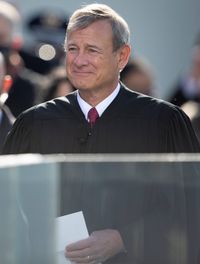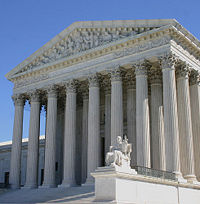Supreme Court of the United States: Difference between revisions
imported>Caesar Schinas m (Bot: Adding) |
Pat Palmer (talk | contribs) mNo edit summary |
||
| (37 intermediate revisions by 10 users not shown) | |||
| Line 2: | Line 2: | ||
{{Image|US Supreme Court Building.jpg|right|200px|The U.S. Supreme Court Building in Washington, D.C.}} | {{Image|US Supreme Court Building.jpg|right|200px|The U.S. Supreme Court Building in Washington, D.C.}} | ||
The '''Supreme Court of the United States | The '''Supreme Court of the United States''' is the highest federal court in the [[United States of America]]; it is sometimes referred to using the acronym SCOTUS. It consists of nine justices, including a [[Chief Justice of the United States|Chief Justice]] and eight [[Associate Justice of the Supreme Court of the United States|associate justices]]. Justices are nominated by the [[President of the United States of America|President]] and confirmed by the [[U.S. Senate|Senate]]; they then serve "for life" or until they voluntarily retire or are incapacitated. | ||
As of 2023, seven of the nine justices were appointed by Republican presidents, and only two by a Democratic president, with the result that the current court leans strongly towards conservative viewpoints. Three of the nine justices are women (two Democratic appointees and one Republican appointee). One justice is African American. | |||
See the [[Supreme_Court_of_the_United_States/Catalogs/Justices|catalog of justices]] for the history of members serving on the court. Scroll to the bottom of the list to see contemporary judges. | |||
Article Three of the [[U.S. Constitution]] defines the original and appellate jurisdiction of the Supreme Court, which includes appeals of federal and state cases and trials of cases where a State or foreign ambassador is a party, although the Eleventh Amendment somewhat limits the jurisdiction of federal courts. There is no constitutional specification of how many justices make up the Court, and Congress increased the number as the nation grew. The authority of this court, to strike down any unconstitutional action of one of the other two branches of government, was firmly established in ''Marbury v. Madison'' (1803), a self-asserted authority taken by the Court and by Chief Justice Marshall maintained to the present time. | |||
==History== | |||
{{main|History of the Supreme Court of the United States of America}} | |||
* [[Clarence Thomas]], a 1991 [[George H. W. Bush]] appointee, is the second African-American to serve on the Supreme Court after [[Thurgood Marshall]], and has a conservative judicial philosophy, adhering to [[originalism]] | |||
* [[ | ===Establishment=== | ||
* [[ | The Supreme Court is the only court that is provided for specifically in the Constitution, which, in Article III section 1, vests the United States government's judicial power in "one Supreme Court, and in such inferior courts as the Congress may from time to time ordain and establish." | ||
* [[Samuel Alito]], a 2006 [[George W. Bush]] appointee, a conservative Catholic, nominated after Bush failed to nominate [[Harriet Miers]] to the court | |||
In the [[Judiciary Act of 1789]], Congress determined that the Supreme Court would consist of a chief justice and five associate justices. The Supreme Court justices would meet in the national capital for two sessions each year and, when not in session, "ride circuit" to serve on intermediate appellate courts in the rest of the country. | |||
===From the John Jay Court to the John Marshall Court=== | |||
===The Taney Court=== | |||
===The Chase Court and the Waite Court=== | |||
===Melvin W. Fuller, Edward D. White, and William Howard Taft=== | |||
===The 1930s and FDR’s Court-Packing Plan=== | |||
===Earl Warren and Warren Burger=== | |||
===The Rehnquist Court=== | |||
==The Current Court== | |||
{{Image|Johngrobertsjr-2021.jpg|right|200px|Chief Justice [[John G. Roberts, Jr.]] at the swearing-in of President [[Joe Biden]] on January 20, 2021.}} | |||
The current Chief Justice is [[John Roberts|John G. Roberts, Jr.]], whom [[George W. Bush]] appointed in September 2005. Roberts is a Harvard-trained lawyer and former Associate Counsel to the President. | |||
The current associate Justices (in order of seniority) are: | |||
* [[Clarence Thomas]], a 1991 [[George H. W. Bush]] appointee, is the second African-American to serve on the Supreme Court, after [[Thurgood Marshall]], and has a conservative judicial philosophy, adhering to [[originalism]]. | |||
* [[Stephen Breyer]], a 1994 [[Bill Clinton|Clinton]] appointee, and the leading liberal Justice on the court. | |||
** [[Ketanji Brown Jackson]] approved by Congress in April 2022 to replace Justice Breyer sometime in the summer of 2022 | |||
* [[Samuel Alito]], a 2006 [[George W. Bush]] appointee, a conservative Catholic, nominated after Bush failed to nominate [[Harriet Miers]] to the court. | |||
* [[Sonia Sotomayor]], was appointed in 2009 by [[Barack Obama]]. She is the first Hispanic and only the third woman to serve on the Court. | |||
* [[Elena Kagan]], appointed in 2010 by [[Barack Obama]], is a former dean of the Harvard Law School and former [[Solicitor General (U.S.)|U.S. Solicitor General]] in the Obama administration. | |||
* [[Neil Gorsuch]], nominated by [[Donald Trump]] in January 2017 | |||
* [[Brett Kavanaugh]], nominated by Donald Trump in July 2018 | |||
* [[Amy Coney Barrett]], appointed by Donald Trump on Oct. 27, 2020 | |||
== Women in the Court== | |||
[[Sandra Day O'Connor]] (b. 1930) was the first woman to serve on the Supreme Court; she was appointed in 1981 and retired in 2006. The second was [[Ruth Bader Ginsburg]] (appointed 1993; 1933-2020). | |||
==Supreme Court Justices== | |||
{{Image|Justices full.jpg|right|250px|The 2006 Court.}} | |||
[[Supreme Court of the United States/Catalogs/Justices|See catalog]]. | |||
==Notes== | ==Notes== | ||
<references/> | <references/> | ||
Revision as of 17:02, 13 March 2023
The Supreme Court of the United States is the highest federal court in the United States of America; it is sometimes referred to using the acronym SCOTUS. It consists of nine justices, including a Chief Justice and eight associate justices. Justices are nominated by the President and confirmed by the Senate; they then serve "for life" or until they voluntarily retire or are incapacitated.
As of 2023, seven of the nine justices were appointed by Republican presidents, and only two by a Democratic president, with the result that the current court leans strongly towards conservative viewpoints. Three of the nine justices are women (two Democratic appointees and one Republican appointee). One justice is African American.
See the catalog of justices for the history of members serving on the court. Scroll to the bottom of the list to see contemporary judges.
Article Three of the U.S. Constitution defines the original and appellate jurisdiction of the Supreme Court, which includes appeals of federal and state cases and trials of cases where a State or foreign ambassador is a party, although the Eleventh Amendment somewhat limits the jurisdiction of federal courts. There is no constitutional specification of how many justices make up the Court, and Congress increased the number as the nation grew. The authority of this court, to strike down any unconstitutional action of one of the other two branches of government, was firmly established in Marbury v. Madison (1803), a self-asserted authority taken by the Court and by Chief Justice Marshall maintained to the present time.
History
Establishment
The Supreme Court is the only court that is provided for specifically in the Constitution, which, in Article III section 1, vests the United States government's judicial power in "one Supreme Court, and in such inferior courts as the Congress may from time to time ordain and establish."
In the Judiciary Act of 1789, Congress determined that the Supreme Court would consist of a chief justice and five associate justices. The Supreme Court justices would meet in the national capital for two sessions each year and, when not in session, "ride circuit" to serve on intermediate appellate courts in the rest of the country.
From the John Jay Court to the John Marshall Court
The Taney Court
The Chase Court and the Waite Court
Melvin W. Fuller, Edward D. White, and William Howard Taft
The 1930s and FDR’s Court-Packing Plan
Earl Warren and Warren Burger
The Rehnquist Court
The Current Court

Chief Justice John G. Roberts, Jr. at the swearing-in of President Joe Biden on January 20, 2021.
The current Chief Justice is John G. Roberts, Jr., whom George W. Bush appointed in September 2005. Roberts is a Harvard-trained lawyer and former Associate Counsel to the President.
The current associate Justices (in order of seniority) are:
- Clarence Thomas, a 1991 George H. W. Bush appointee, is the second African-American to serve on the Supreme Court, after Thurgood Marshall, and has a conservative judicial philosophy, adhering to originalism.
- Stephen Breyer, a 1994 Clinton appointee, and the leading liberal Justice on the court.
- Ketanji Brown Jackson approved by Congress in April 2022 to replace Justice Breyer sometime in the summer of 2022
- Samuel Alito, a 2006 George W. Bush appointee, a conservative Catholic, nominated after Bush failed to nominate Harriet Miers to the court.
- Sonia Sotomayor, was appointed in 2009 by Barack Obama. She is the first Hispanic and only the third woman to serve on the Court.
- Elena Kagan, appointed in 2010 by Barack Obama, is a former dean of the Harvard Law School and former U.S. Solicitor General in the Obama administration.
- Neil Gorsuch, nominated by Donald Trump in January 2017
- Brett Kavanaugh, nominated by Donald Trump in July 2018
- Amy Coney Barrett, appointed by Donald Trump on Oct. 27, 2020
Women in the Court
Sandra Day O'Connor (b. 1930) was the first woman to serve on the Supreme Court; she was appointed in 1981 and retired in 2006. The second was Ruth Bader Ginsburg (appointed 1993; 1933-2020).

